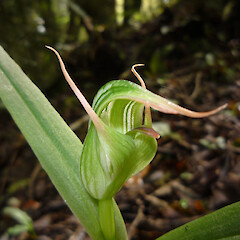Pterostylis banksii
Common name
tutukiwi, greenhood
Synonyms
Pterostylis emarginata Colenso, Pterostylis macrophylla A.Cunn. ex Hook.f. nom. illegit.
Family
Orchidaceae
Flora category
Vascular – Native
Endemic taxon
Yes
Endemic genus
No
Endemic family
No
Structural class
Orchids
NVS code
The National Vegetation Survey (NVS) Databank is a physical archive and electronic databank containing records of over 94,000 vegetation survey plots - including data from over 19,000 permanent plots. NVS maintains a standard set of species code abbreviations that correspond to standard scientific plant names from the Ngä Tipu o Aotearoa - New Zealand Plants database.
PTEBAN
Chromosome number
2n = 44
Current conservation status
The conservation status of all known New Zealand vascular plant taxa at the rank of species and below were reassessed in 2017 using the New Zealand Threat Classification System (NZTCS) – more information about this can be found on the NZTCS website. This report includes a statistical summary and brief notes on changes since 2012 and replaces all previous NZTCS lists for vascular plants.
Please note, threat classifications are often suggested by authors when publications fall between NZTCS assessment periods – an interim threat classification status has not been assessed by the NZTCS panel.
- Conservation status of New Zealand indigenous vascular plants, 2017 . 2018. Peter J. de Lange, Jeremy R. Rolfe, John W. Barkla, Shannel P. Courtney, Paul D. Champion, Leon R. Perrie, Sarah M. Beadel, Kerry A. Ford, Ilse Breitwieser, Ines Schönberger, Rowan Hindmarsh-Walls, Peter B. Heenan and Kate Ladley. Department of Conservation. Source: NZTCS and licensed by DOC for reuse under the Creative Commons Attribution 4.0 International licence.
2017 | Not Threatened
Previous conservation statuses
2012 | Not Threatened
2009 | Not Threatened
2004 | Not Threatened
Distribution
Endemic. New Zealand: North Island, South Island, Stewart Island/Rakiura, Chatham Islands
Habitat
Coastal to montane (up to 800 m a.s.l.). In indigenous or exotic forests and shrubland.
Detailed description
Terrestrial, tuberous, glabrous, spring to summer-green perennial herb, forming dense colonies of numerous plants through vegetative extension. Plant at flowering 100–680 mm tall. Stem stiffly erect, smooth, dark green to reddish green, internodes shorter than leaves throughout. Leaves 4–6, sessile, stiffly erect to curved and more or less drooping, dark green to yellow green with entire margins; in sterile plants lamina of similar size, oblong-elliptic to broadly lanceolate; in flowering plants lamina changing in size from base to top of stem; lamina of largest leaves 50–250 × 10–20 mm, lanceolate to linear-lanceolate, keeled, often with 2 laterals on either side of midrib, apex acuminate to long acuminate, base wider than rest of lamina broadening into a long sheathing base; mostly overtopping flower. Flower 1–(2), erect, front mostly green finely striped with white, stripes of white widening toward back of galea with green narrowing, back of galea sometimes completely white. Ovary erect. Dorsal sepal distinctly broadly ovoid to subglobose, 25–50 mm tall, erect, distal portion usually more or less horizontal in fully open flowers, apex tapering to a long caudate, upturned tip up to 25 mm long and usually exceeding the lateral sepals. Lateral sepals diverging at a narrow angle, caudae of lobes up to 20 mm long, tapered, erect or strongly deflexed backwards, not or scarcely decurved. Petals much shorter than dorsal sepal with acuminate apices. Labellum elliptic-oblong, scarcely arched, flat in cross-section, narrowing slightly towards tip, bending forwarding smoothly and symmetrical, protruding from lateral sepals sinus, midrib initially prominent soon evanescent toward the obtuse, often cucullate apex. Column as tall as or slightly taller than labellum; stigma ellipsoid, scarcely distinguished from column and rather flat.
Manaaki Whenua Online Interactive Key
Similar taxa
Most likely to be confused with to P. patens Colenso, from which it differs by the spreading rather than stiffly erect, lanceolate to linear-lanceolate rather than broadly lanceolate to linear-lanceolate (grassy) leaves which usually overtop the flower; by the dorsal sepal which projects forwards and upwards in a long (up to 23 mm ) tapered caudae, rather than being strongly deflexed downwards; and by lateral sepals whose caudae are erect or deflexed backwards but never strongly deflexed back and down, sometimes meeting at the back of the ovary. Both species are frequently sympatric in the central North Island. The distinction between P. banksii and P. australis Hook.f. can at times be difficult. Pterostylis australis differs from P. banksii by the shorter, broader leaves, which mostly just reach rather than overtop the flower, by its much shorter dorsal sepal and consistently arched labellum. Pterostylis banksii has a superficial similarity to Pterostylis irwinii D.L.Jones, Molloy et M.A.Clem., which differs by its very slender, erect, dark green to reddish green leaves, incurved lateral sepals which cause the sepals to prominently lean forward of the rest of the flower thereby forming an inward turning jug spout at the sinus, and by the green, broadly lanceolate to oblong-lanceolate labellum, which has a distinct black central ridge terminating in a reddish cupular apex.
Flowering
September–November
Flower colours
Green, White
Fruiting
November–February
Propagation technique
Difficul. For cultivation requirements see other Pterostylis.
Etymology
pterostylis: Winged column
banksii: Named after Sir Joseph Banks, 1st Baronet, GCB, PRS (24 February 1743 - 19 June 1820) was an English naturalist, botanist and patron of the natural sciences.
Where To Buy
Not commercially available.
Attribution
Fact Sheet prepared for NZPCN by P.J. de Lange 14 April 2007: Description adapted from Moore and Edgar (1970).
References and further reading
Moore LB, Edgar E. 1970. Flora of New Zealand, Volume II. Indigenous Tracheophyta: Monocotyledones except Gramineae. Government Printer, Wellington, NZ. 354 p.
NZPCN Fact Sheet citation
Please cite as: de Lange, P.J. (Year at time of access): Pterostylis banksii Fact Sheet (content continuously updated). New Zealand Plant Conservation Network. https://www.nzpcn.org.nz/flora/species/pterostylis-banksii/ (Date website was queried)

















